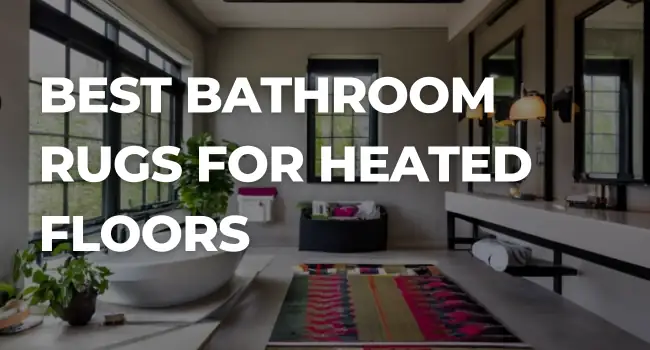Last updated on October 28th, 2023 at 01:02 pm
When it comes to creating a cozy and inviting bathroom, heated floors are a luxurious addition. But what could make this experience even better? The answer is simple: bathroom rugs for heated floors. These rugs not only enhance the aesthetics of your bathroom but also provide warmth, comfort, and safety. In this comprehensive guide, we will explore the benefits of using bathroom rugs on heated floors, the best types of rugs, materials to consider, maintenance tips, and much more. Let’s dive in.
Benefits of Using Bathroom Rugs on Heated Floors
1. Warmth and Comfort
Heated bathroom floors offer a toasty surface, but stepping on them directly may still feel chilly, especially during colder months. A bathroom rug provides that immediate warmth and comfort your feet crave when you step out of the shower.
2. Safety
Heated floors can be slippery when wet, increasing the risk of accidents. A bathroom rug not only absorbs excess water but also provides traction, making your bathroom safer.
3. Aesthetic Enhancement
Bathroom rugs come in various styles and designs, allowing you to personalize your space and complement your bathroom decor.
Do You Need a Bath Mat with Heated Floors?
While not an absolute necessity, bath mats or rugs are highly recommended with heated floors. They offer practical benefits, such as warmth and safety, making your bathroom experience more enjoyable.
What Kind of Rug is Best for Underfloor Heating?
When choosing a rug for heated floors, opt for a rug made of materials that don’t obstruct heat transfer. Thin rugs with natural materials like cotton or microfiber work well, as they allow heat to pass through while providing comfort.
- Material: Opt for rugs made from natural, breathable materials like wool or cotton. These materials are good conductors of heat and allow heat to flow through to the room. Avoid rugs made of synthetic materials like rubber or plastic, as they can trap heat and potentially damage the heating system.
- Low Pile: Rugs with a low pile, such as flatweave or Berber, are better suited for underfloor heating. These rugs have a thinner profile, which allows heat to radiate more effectively.
- Size: Choose a rug that’s smaller than the area covered by the underfloor heating. Leaving some of the floor exposed ensures that heat can disperse evenly throughout the room.
- Ventilation: Consider using a rug pad with small holes or a mesh design to allow for proper ventilation. This helps heat circulate and prevents the rug from acting as an insulator, which can hinder the efficiency of the heating system.
- Non-slip Backing: Look for rugs with a non-slip backing or use a non-slip rug pad. This prevents the rug from shifting and potentially causing damage to the heating system.
- Heat Resistance: Make sure the rug is heat-resistant to withstand the temperatures generated by the underfloor heating system. This information is often available in the rug’s specifications.
- Regular Maintenance: Keep the rug clean and free of debris to maintain efficient heat distribution. Dust and dirt can act as insulators, reducing the effectiveness of the heating system.
- Avoid Heavy Furniture: If you have a rug over underfloor heating, be cautious about placing heavy furniture on it, as this can compress the rug and trap heat.
- Test It: Before placing a rug over the underfloor heating system, perform a test to ensure it doesn’t obstruct heat flow or cause any adverse effects.
Factors That Make a Bathroom Rug Compatible with Heated Floors
1. Material
Choose rugs made of materials like cotton, microfiber, or memory foam. These materials are not only compatible with heated floors but also comfortable to step on.
2. Thickness
A thin rug or mat is ideal for heated floors as it ensures the heat can pass through effectively. Avoid thick, insulating rugs, which may reduce the heating efficiency.
Can You Put Rugs on Heated Bathroom Floors?
Yes, you can put rugs on heated bathroom floors. In fact, it’s a popular choice to enhance comfort and safety in your bathroom. Nonetheless, the placement of a rug over a heated floor may impede the transfer of heat from the floor to the surrounding space.
What Materials are Best for Bathroom Rugs on Heated Floors?
Let’s take a closer look at the materials commonly used for bathroom rugs:
- Microfiber: Known for its absorbent and quick-drying qualities, microfiber is an excellent choice for bathroom rugs. It’s soft on your feet and compatible with heated floors.
- Cotton: Cotton rugs are natural and moisture-absorbent. They feel soft and provide warmth, making them a great option for heated bathroom floors.
- Memory Foam: Memory foam rugs offer a plush and comfortable surface. They also absorb water efficiently and are compatible with heated floors.
How Do Heated Floors Work, and Why are They Beneficial?
Heated floors, often referred to as radiant floor heating, work by running electrical wires or tubing for hot water beneath the flooring. They emit heat, warming the floor, which in turn radiates warmth into the room. This method is energy-efficient and provides even heat distribution, making it highly beneficial.
Some advantages of heated floors include energy efficiency, even heating, and allergy reduction. They also eliminate the need for unsightly radiators or vents.
What is the Ideal Size for a Bathroom Rug on a Heated Floor?
The ideal rug size depends on your bathroom’s layout and personal preferences. As a general guideline:
- For a small bathroom, consider a rug that covers most of the floor space.
- In a larger bathroom, opt for multiple smaller rugs or a larger one that doesn’t cover the entire floor.
What Features Should I Look for in Bathroom Rugs for Heated Floors?
When shopping for bathroom rugs for heated floors, consider the following features:
1. Slip Resistance
Ensure the rug has a non-slip backing to prevent accidents, especially on heated, potentially slippery floors.
2. Water Absorption
Look for rugs that can absorb moisture quickly to keep your bathroom dry and safe.
3. Ease of Cleaning
Choose rugs that are easy to clean and maintain. Machine-washable options are a convenient choice.
Are There Specific Design Considerations for Bathroom Rugs in a Heated Floor Environment?
The design of your bathroom rug can significantly impact the overall aesthetics of your bathroom. Choose a rug that complements your decor and personal style, whether it’s a simple, classic design or something more vibrant and colorful.
How Can I Clean and Maintain Bathroom Rugs on Heated Floors?
Proper maintenance is crucial to prolong the life of your bathroom rug. Here are some tips:
- Regularly shake out or vacuum the rug to remove debris.
- Follow the care instructions provided by the manufacturer.
- Machine wash your rug if it’s machine-washable.
- Allow the rug to thoroughly dry before placing it back on the heated floor.
Can I Use Heated Floor Mats or Rugs as a Primary Heating Source in My Bathroom?
Heated floor mats or rugs can certainly provide supplemental heating in your bathroom. However, they may not be sufficient as the primary heating source, especially in larger bathrooms. It’s best to combine them with the existing heating system for optimal results.
Customer Reviews and Recommendations for Best Bathroom Rugs on Heated Floors
To give you a sense of what users are saying, here are a few real-life experiences and recommendations:
| Key Points |
|---|
| Suggests that rubber, depending on the type, can withstand temperatures up to 200°F. |
| Notes that if the temperature sensor is under the mat, the rest of the floor won’t heat up, but it shouldn’t cause damage. |
| Specifies that the maximum temperature for the floors is 78-80 degrees when radiant mats are installed under the tile. |
| Shares an experience of having area rugs with a rubber rug pad on a heated basement floor without issues. |
| Offers advice on rugs for radiant heating systems, mentioning the importance of avoiding rubber in rug cushions. |
| Shares that they still use bath mats in bathrooms with heated floors, noting that mats don’t feel as warm as the floors. |
| Recommends using a thin, no-backing rug in a heated floor bathroom. |
DIY Options for Creating Heated Bathroom Rugs
If you’re a fan of DIY projects, you can create heated bathroom rugs by incorporating heating elements beneath a rug or mat.
Creating heated bathroom rugs as a DIY project can be a unique way to add warmth and comfort to your bathroom. While it’s essential to approach this project with caution to ensure safety, here are some DIY options for creating heated bathroom rugs:
- Underfloor Heating System:
- One of the most effective methods is to install an underfloor heating system designed for bathrooms. These systems typically consist of electric radiant heating mats or cables that can be installed under the bathroom floor tiles.
- You can install these systems yourself if you have experience with electrical work. However, it’s essential to follow the manufacturer’s instructions carefully and ensure all electrical connections are secure and waterproof.
- Once the underfloor heating system is installed, you can place a rug on top of the heated tiles, and it will provide warmth and comfort.
- Electric Blanket or Heated Pad:
- Another DIY option is to use an electric blanket or heated pad as the base for your bathroom rug. Choose one that is suitable for bathroom use and can withstand moisture.
- Secure the electric blanket or pad to the underside of your chosen rug. Make sure all electrical connections are properly sealed to prevent water damage.
- When turned on, the electric blanket or pad will radiate heat through the rug, creating a heated bathroom rug.
- DIY Heated Cable System:
- You can create a DIY heated rug by using heating cables designed for in-floor heating. These cables can be woven or attached to a mesh or fabric base.
- Secure the heating cables evenly across the underside of your rug, leaving some space between the cables to prevent overheating.
- Connect the cables to a suitable thermostat and power source, following all electrical safety guidelines. Ensure that all connections are waterproof.
- When you turn on the system, the cables will generate heat and warm up the rug.
- Pipe Heating Cable:
- Another option is to use pipe heating cables, which are designed to prevent pipes from freezing. These can be repurposed for a DIY heated rug.
- Arrange the heating cables in a grid pattern on the underside of your rug. Make sure they are evenly spaced and secured.
- Connect the cables to a thermostat and power source, ensuring that all electrical components are waterproof.
- When activated, the pipe heating cables will generate warmth, heating the rug.
Remember that safety is paramount when working with electricity and water in a bathroom setting. It’s crucial to follow all electrical codes and safety guidelines. If you’re not experienced with electrical work, it may be best to consult a professional electrician to ensure a safe installation. Additionally, ensure that your DIY heated bathroom rug is designed to withstand moisture and is easy to clean.
In conclusion, bathroom rugs for heated floors are a fantastic addition to any bathroom, offering warmth, comfort, and safety. When choosing the right rug, consider materials, thickness, size, and design to enhance your bathroom’s overall appeal. Combine the benefits of heated floors with a well-chosen rug, and you’ll transform your bathroom into a luxurious oasis.
Now, you’re well-equipped to make an informed decision on the best bathroom rug for your heated floors. Whether you prefer microfiber, cotton, or memory foam, there’s a perfect rug waiting to add that extra touch of warmth and style to your bathroom.
For more information and expert insights on heated floors and bathroom rugs, check out these authoritative sources:



